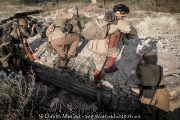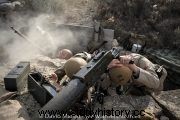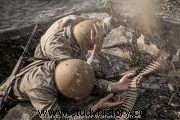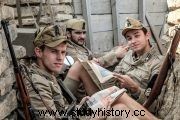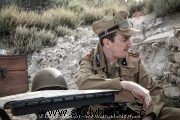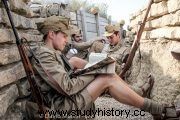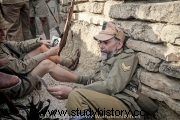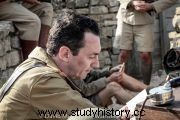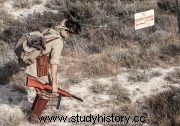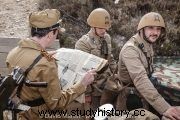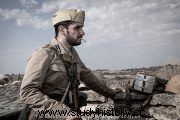
Since the birth of the Fighting Basques Project of the Sancho de Beurko Association we developed a concept (that of the support groups) that, although it seems little more than an extravagance of ours, could very well be extended to other groups of historical reenactment who work on memorial issues and who, for obvious reasons —the same thing happens to us too—, depend on the collaboration of others to develop their stagings. These memory groups are very rare on the state scene (we could point to the one that has always inspired us the most, the Poland First to Fight , which goes far beyond covering the deployment and history of a specific military unit, as most do, covering the memory of the Polish people during the Second World War [1]) and carry out their activity in public recreations, since normally they understand memory as a way of connecting with a receptive public to a staging of a historical nature.
The attraction that the memory of the Second World War has for all European states in the construction of its national identity has had a curious reflection in Spain through these groups (there are also Soviet-inspired groups, with strong ties to representatives of the Russian community), which stage this memory under the umbrella of historical re-enactment . If we believe, as Paulo Raposo says, that a certain re-traditionalization of the elements of popular culture is taking place by agents external to the communities of origin to generate these "expressive manifestations" that are the recreations (2), the more so if what is It is about staging history outside the country, that is, if the management of the performances of their own or local history remains outside the communities of origin, others such as those whose scope is the Second World War, with much more reason, have also remained in the hands of private promoters, which is why historical re-enactment associations always try to fit their projects as well as they can, which has a lot of merit.
For all these reasons, it is worth asking whether these events of foreign history and culture (in fact, almost everything related to the Second World War in Spain is) always have sufficient historical justification to be held or if the chosen framework is the most appropriate. Given this, the groups with their own project, which are the ones that normally work rigorously and seriously, always look for a way to agree on the script with the organizers so that they can meet their particular objectives (if not all, enough so that it at least deserves worth the trip), while some of the participants, sadly, don't care about all of that. History, in these cases, is nothing more than an excuse to wear this or that uniform, and not always in a fortunate way (the latter are derogatorily called "Farbs", although we do not like the term because it induces discrimination), although in the end there is little that lends itself to it, starting with an inappropriate and normally urban setting, but everyone is very free to make their cape a tunic.
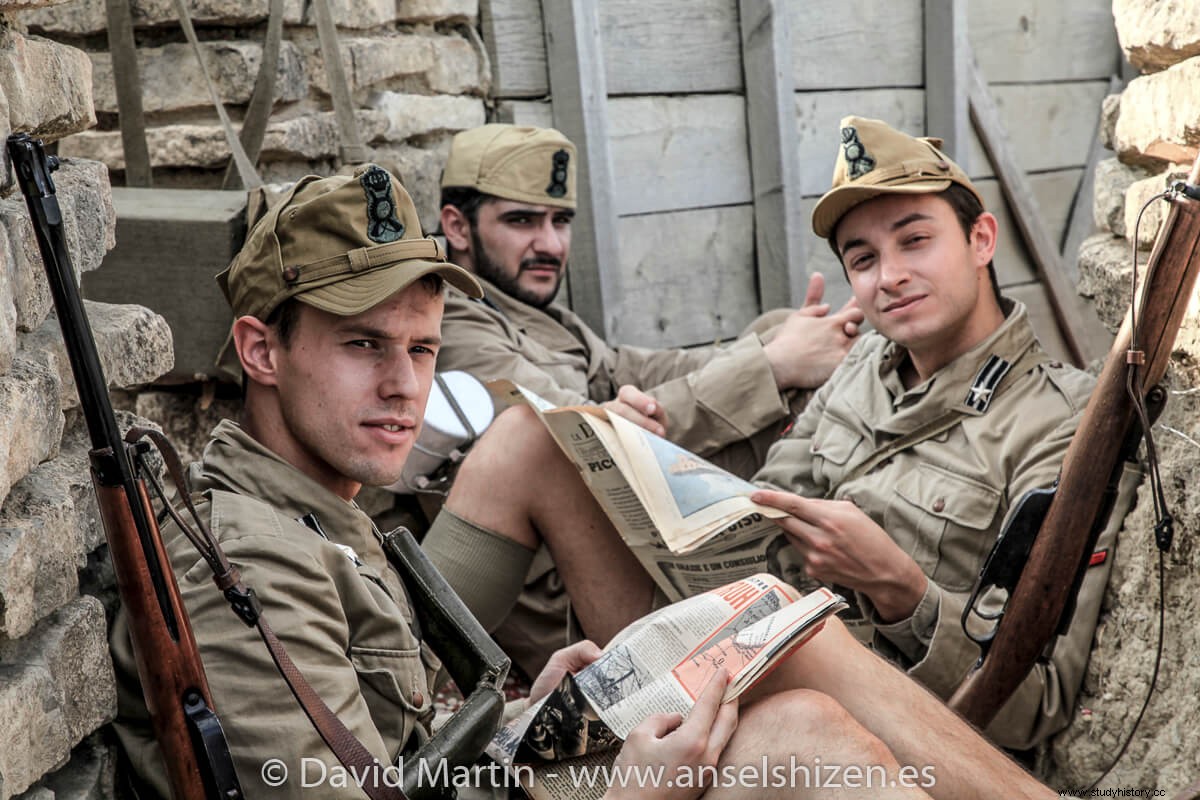
In our case, and in order not to be slaves of seeking the necessary tranquility that our photo sessions require, we decided to guide this need, which for us was support, help, towards the creation of new groups within the Fighting Basques Project and recreate, depending on the circumstances, Germans, Italians and Japanese, but always with the aim of composing the scenes that our memory project – about Basques in World War II – needed, obtaining images to make our research based on history visible familiar (3). Thus the support groups were born. In 2015, during the photo sessions we did in the historical settings where the Gernika battalion fought at Pointe de Grave (the Médoc peninsula [Aquitaine], whose 75th anniversary is now celebrated), we found ourselves there with great difficulties in composing soldiers Germans due to a matter of logical revulsion towards those who invaded them between 1940 and 1945, but also due to the lack of a deep debate in the neighboring country regarding memorial issues that we do not have time to deal with here due to the limitations of this article, always, of course, under the premise of respect and the absence of value judgments on our part, since it is a matter that concerns the French exclusively.
In fact, this revulsion for the German uniform was already happening a long time ago in Normandy, converted into a sort of Disneyland of performances with an influx of hundreds of thousands of people year after year on the occasion of the anniversaries of D-Day (4), a scenario that is very far, and not only geographically, from the Aquitaine-Bordelaise region, where these issues arouse very little interest among the population and fall on local associations that try, with no little merit, to value the built heritage of the Atlantic Wall.
Focusing on our first memory work, that of the Gernika battalion, it was decided to compose characters from the German coastal artillery group deployed at Pointe de Grave (Marine Artillerie Abteilung 618, to which the Basques clashed at the battery of Les Arros [Soulac sur Mer] on April 19, 1945), but they would still have to wait three long years to be able to compose Italians. The concept, to which not only members of the Association but also several friends at a private level joined, was based on respect for the opponent as a conditioning factor, so that, without having to share or assume any ideological issue, much less justify totalitarianism (a premise in historical recreation), the support groups were also memory groups in order to seek a sincere reconciliation between peoples after overcoming armed conflicts. It was the least we could do, since as a family history project we had an obligation to the community.
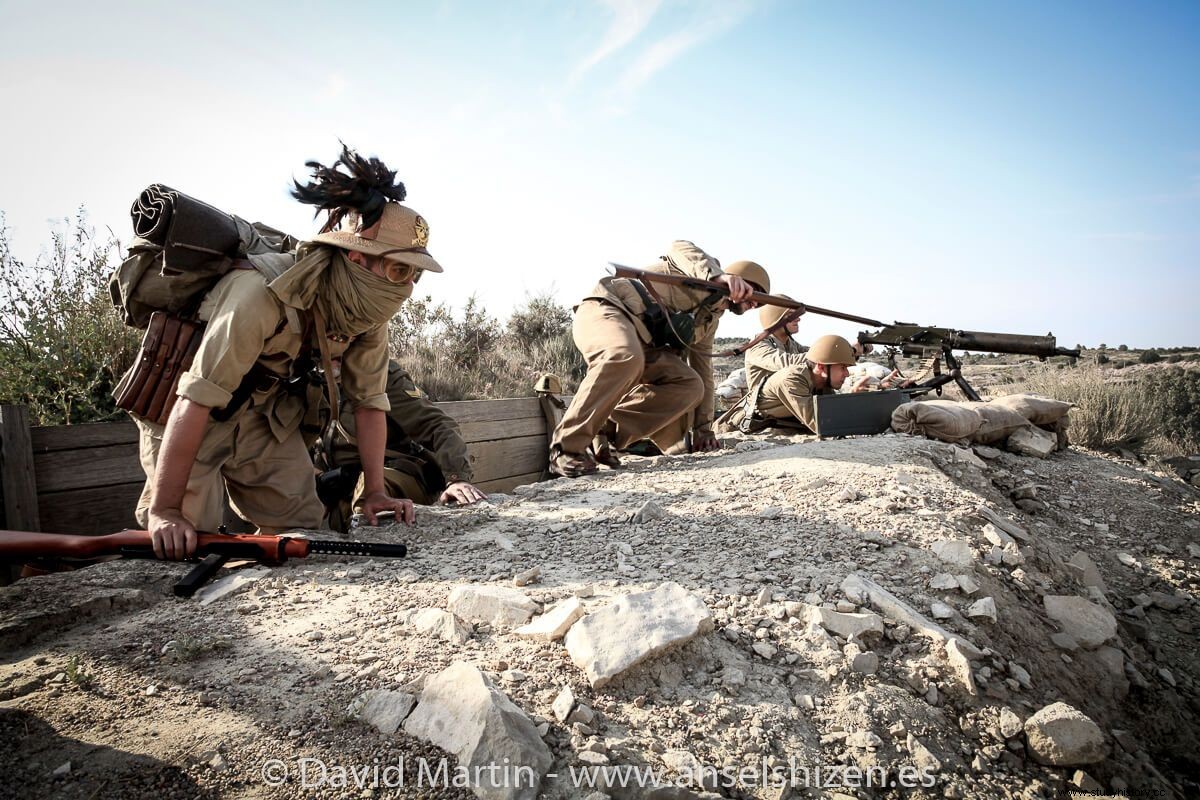
At the very least, we find it much more hopeful to cite as motto that phrase attributed to Napoleon Bonaparte that says that "he who does not know his history is condemned to repeat it", reiterated ad nauseam by numerous reenactors when interviewed by different media, attributing to historical reenactment an educational function that, although It is true that it has, it can be disturbing at times, since not all the public that attends the performances understand the battle that is presented to them, externalized with firecrackers and pyrotechnics that can overwhelm young and old, even producing moments that They range from fear to mockery and ridicule of the respectable that all re-enactors have ever experienced. On the other hand, with other practices, which do not necessarily have to go through the war event itself, the potential would be enormous, as indicated by José Juan de Paz and Mario Ferreras, who propose starting by providing students with the necessary historical knowledge and then refer him to related activities such as clothing and accessories, food, and way of life, but "only if they are carried out within a context where attitudes of education for peace and tolerance of cultures are fostered." In this sense, we would highlight the work of Civil War groups such as the Nalón Front or the First Line, which are advancing towards the realization of interesting projects (5).
Recreating the Trieste Division at Bir Hakeim
Going back to the Italian question, when we dealt with the 13e demi brigade of Légion étrangère We barely had time to compose a couple of sets for our book Basque Combatants in World War II and the opportunity to recreate Italians as a support group on the North African stage was left out, an issue that attracted us a lot because it was the first time that this had been done at the state level, and it was not a trivial matter. The recreation of Alcubierre (Huesca) in July 2018 and the kindness of the organization of the event offered us the right setting and the opportunity to work on this memory, for which we required the help of some friends such as Ignacio del Horno -one of the best specialists in the matter–, Guillermo Fernández-Coppel and Jordi Espriu, since the three of them had worked on the Italian theme with very elaborate uniforms and excellent knowledge of the characters, having composed Ignacio, among others, an artillery lieutenant from Trieste and both Guillermo as Jordi both Bersaglieri (6).
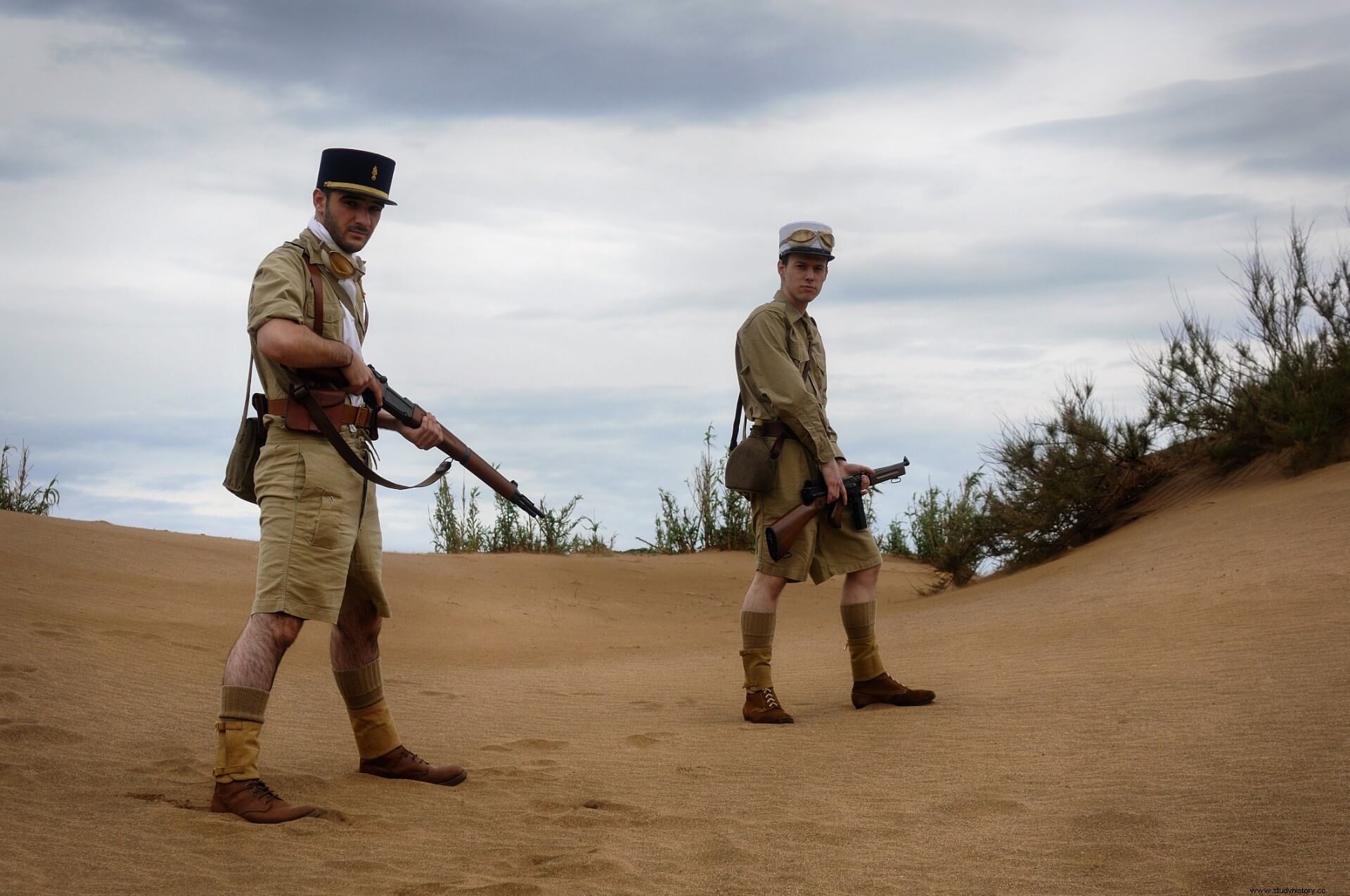
The setting chosen for this new scenery that led us More than two years of work formed the trenches of Mount Irazo in what is known as the "Orwell Route" in the Sierra de Alcubierre, a center of resistance from the Spanish Civil War on top of a hill that has been rebuilt with an adequate interpretation of the materials of the time, although in a somewhat free way, with active trench elements, linings for slopes, shelters and observatories. We already highlighted in its day its great potential for carrying out activities related to the enhancement of heritage, rather with its socialization, such as historical recreation and audiovisual production, in addition to promoting various activities with guided tours that may well finish at the nearby Robres Civil War Interpretation Center in the midst of an attractive, almost desert-like setting that has remained virtually unchanged, but was unusually green at the time of the photo shoot due to the abundance of rain in 2018 which, paradoxically, was not good for the field. It is fair to point out that this abnormal "leafiness" did not allow us to fully achieve the desert effect we were looking for -and that had taken us there- so we had to work in very close shots with our photographer, David Martín "Ansel Shizen" from Zaragoza. ”. A great professional whose good work is attested by the images that accompany these lines.
Doing a bit of history, the goal was to recreate the positions excavated by the troops of the 1st Free French Brigade in front of the old Turkish fortress of Bir Hakeim – a strategic enclave in the middle of the Libyan desert that had already seen the passage of numerous armies since time immemorial – on the so-called El Gazala line between May and June 1942, but just after the epic battle that took place there, when these had already been forced to withdraw after a resistance that would ultimately delay German Marshal Erwin Rommel's plans to reach the Suez Canal, allowing the reestablishment of the entire British device on a new line around El Alamein. 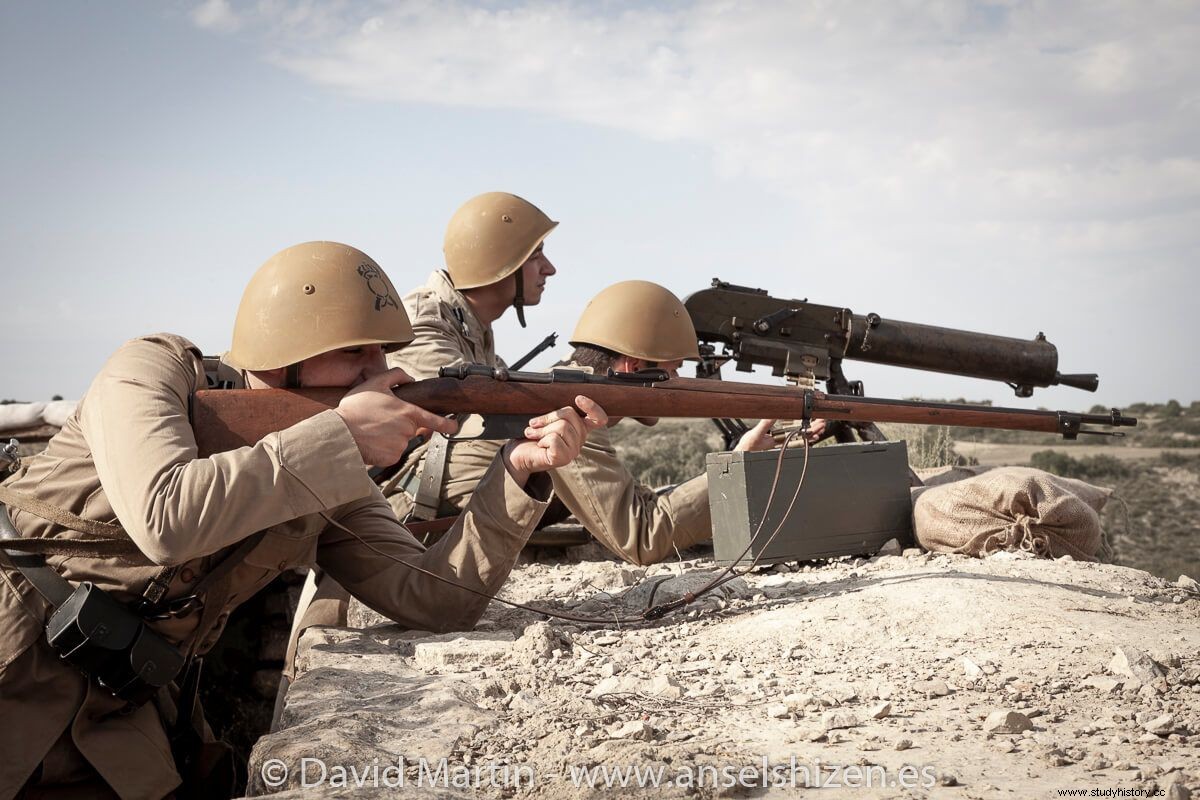
The French would leave on the ground during the fighting a total of 140 dead, 229 wounded and 814 prisoners who were transferred by the Italians to Benghazi to be shipped to the metropolis. Among the Free French contingent there were at least twenty Basques forming part of various units such as the 13th, the marine rifle battalion or even other smaller ones (eg, the 101e Compania Automobile). Of all of them, José Artazcoz from San Sebastian fell during the battle and Pamplona's Hermenegildo "Eloy" Huarte Satostegui and Bayonnais were taken prisoner. Charles Edouard Lasbordes, who would die on August 17, 1942 when the ship that took them to Italy, the Nino Bixio , was torpedoed by a British submarine. With this, the interest that this historical fact has in our memory project is amply explained.
Among the Axis units involved in Bir Hakeim, which came to be led personally by Rommel himself given the fierce fighting, was one German, the 90th Motorized Division, and three Italians, the Ariete Armored Division and the Pavia and Trieste Motorized Divisions, being the latter was chosen by us to form the support group as it was involved in combat with the French until the end of these operations with its 66th “Valtellina” Infantry Regiment (7). The Trieste had been used very well in the days of May 29, 1942, when it managed to open a corridor in the middle of the El Gazala line, and on June 12 it played an important role in the destruction of the 2nd and 4th British 1st Armored Brigades, so it was a well-trained and battle-hardened unit that would take part in most of the desert battles – Operation Crusader, Battle of El Gazala, Battle of Bir Hakeim and the two Battles of El Alamein (8)–, being the last major Italian unit to surrender to the Allies on May 13, 1943.
Recreate the Italians of the Trieste Division in North Africa , just as the coastal artillery was in its day, was a unique and very special project because no other group in our environment had done it. This novelty motivated us even more and more than compensated for the great difficulties we encountered, since Italian materials turned out to be very difficult to obtain and were part of a long research process that we will describe below. Our re-enactors Eneko Tabernilla, Eder Artal and Iñaki Peña Eguskiza were in charge of composing the characters.
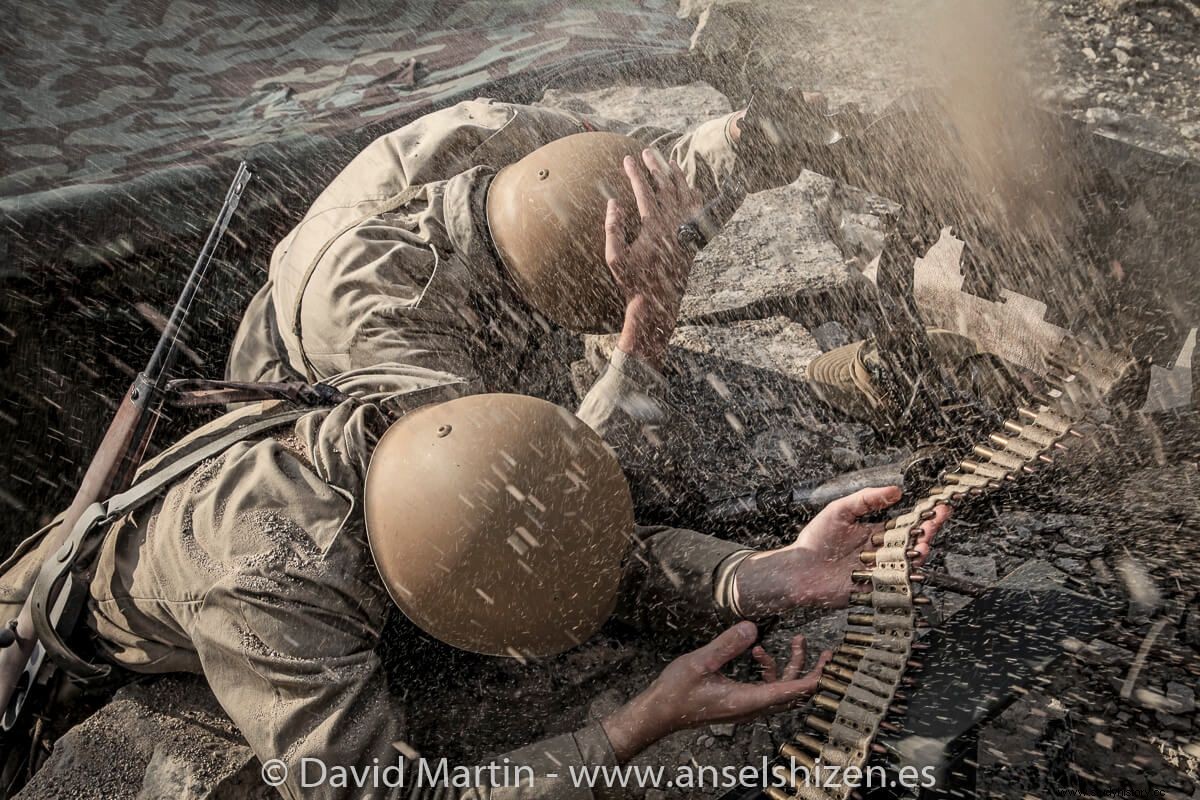
The first assumption that we value for the scenography , and in order to take advantage of the trenches of the "Orwell Route", is that the Italians, after taking over the position of Bir Hakeim, occupied the French fortifications for a short time (a couple of days at most) on the way to Tobruk, establishing defensive positions with light weapons. Considered using a Schwarzlose machine gun , a rifle and a Carcano – carbine all of them unused and from our own collection–, to form a squad of Trieste machine guns, materials that are extremely difficult to obtain at the moment, which gave us a certain advantage when approaching the project. In fact, the Austrian Schwarzlose machine gun , which reached the Italian Regio Esercito as part of the loot that the central powers gave to the countries that emerged victorious from the First World War, was found in large quantities in Libya, being, despite its age, one of the most reliable weapons of the Italian arsenal, sometimes replacing the Breda M30 because of its constant blockages. Once the weapons issue was resolved, uniformity and equipment came to the fore, and imagination had to be used.
The khaki warrior started from the giacca da truppa coloniale mod 29 , which could have been recreated using French colonial warriors to which wooden buttons and mirrors were placed on the infantry collar of the Trieste Division (mostrina ), in addition to other arrangements, shortening the jackets and modifying the cuffs and pocket flaps, discoloring the garments, etc. The team was completed with khaki shirts and shorts, locally made espadrilles like those bought in Tripoli, socks, headwear (bustina and berreto di marcia –m42 colonial hat with the infantry emblem), steel helmets (elmetto M33 ), pots (gavetta ), canteens (borraccia ), rucksack (zaino borsa per armi a cavallo M29 ), gas masks (maschera antigas T35 ), belts with model 1907 magazine holders and bayonet for the rifleman and shoulder strap chargers for the carbine. In order to get the right setting, the box of a Spanish Standard telephone was slightly modified. of war manufacturing to temporarily convert it into a telephone di campale modello 1916 –which is still seen in North Africa and is virtually impossible to obtain– several camouflage ponchos were placed on the trench (mimetico M29 ), including a pre-war tropical one, and barbed wire posts and signs were placed warning of the presence of mines in Italian, taking as a reference a specimen found in the Imperial War Museum from London.

A server raised the recreators a script based on four scenes:the first referred to the arrival of a Bersagliere to a Trieste Division position defended by a Schwarzlose machine gun , for which he had to cross the barbed wire through a duly marked corridor between the mines. The second showed the Bersagliere informing the artillery officer of the situation of the British forces, who immediately requested fire support through the field telephone. The third allowed us to watch the soldiers in a relaxed situation inside the trench in one of the most relaxed moments of the entire set, which they took advantage of to look at photos, leaf through magazines and talk about their things. Finally, the fourth offered a view of the trench under fire from the British cannons and, after the end of the attack, the men ended up going out in the open.
This photo session took place on the afternoon of Friday, July 13, 2018, as part of the Alcubierre recreation but outside the official program, and is indebted to many friends, so I would like to end this article by thanking the local council and Kilroy Etobattles for all the facilities provided to work on the stage of the "Orwell Route", to our friends Ignacio del Horno, Guillermo Fernández-Coppel and Jordi Espriu for the excellent characters they composed for this photo session and to our re-enactors for the effort of making two sets in a row, with all the wear and tear that this entails, in a period of three weeks, since they had just been with the friends of the 6th Battalion Durham Light Infantry "The Durhams" in their living history annual “Escobosa Boot Camp”. The extraordinary images of this scenography of the Trieste Division in Bir Hakeim, as we have pointed out, are by David Martín "Ansel Shizen", a talented photographer from Aragon who honored us with his dedication and interest, this being his first immersion in the world of historical recreation. On a few occasions (with the permission of the Albentosa Memorial March and its extraordinary exteriors) a more favorable framework has been given to recreate and we know that the organization of this Alcubierre event, which is now in its third edition, works hard to establish it on the state scene. From here we wish you all the luck in the world.
Photo gallery
Scenography of the Trieste Division in Bir Hakeim for the Fighting Basques Project. © David Martin “Ansel Shizen”. Click on the photos to enlarge.
Notes
- (1) This group was one of our first references when composing our memory project.
- (2) Paulo Raposo:“Performing culture:historical recreations and heritage interpretations” in Xerardo Pereiro, Santiago Prado, Hiroko Takenaka (coordinators). Cultural heritage:education and interpretation. Crossing boundaries and producing alternatives #12 (2008). Ankulegi Anthropology Elkartea:Donostia. P. 76.
- (3) See the previous article “José María Irala, a child of the war in the Market Garden operation”
- (4) At the time, the mayor of Sainte-Mère-Église and the vice president of the general council, Marc Lefèvre, who were not closed to certain collectors and re-enactors who worked seriously in controlled environments such as museums or the Crisbecq battery, where a stage design is currently made with Germans, but always under the premise of being invited.
- (5) José Juan de Paz Sánchez and Mario Ferreras Listán:“Historical Reenactment in the teaching-learning process in the social sciences:methodology, good practices and professional development” in Rosa María Ávila Ruiz, María Pilar Rivero Gracia and Pedro L. Domínguez Sanz (coordinators). Research methodology in Didactics of Social Sciences. (2010). Ferdinand the Catholic:Zaragoza. P.525.
- (6) To learn more about the Bersaglieri .
- (7) Salvatore Loi. (1983). Aggredisci e vincerai:storia della divisione motorizzata Trieste . Murcia:Milano.
- (8) Walter S. Zapotoczny jr. (2018). The Italian Army In North Africa:A Poor Fighting Force or Doomed by Circumstance. England:Fonthill.


